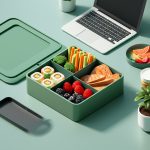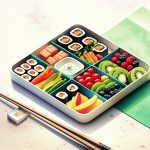In today’s fast-paced work environment, prioritizing healthy eating can seem like a daunting task. Between demanding schedules and constant deadlines, it’s easy to fall into unhealthy eating habits. However, nourishing your body with nutritious foods is essential for maintaining energy levels, boosting productivity, and enhancing overall well-being. This guide provides practical strategies and tips to help busy professionals incorporate healthy eating into their workday, even with limited time and resources. For additional on-the-go tips, check out this helpful guide: Healthy Eating on the Go.
Simple Strategies for Healthy Eating at Work
Eating healthy at work can be achievable with a few simple strategies. This guide offers practical tips to make healthy eating a realistic part of your work routine, promoting both focus and overall well-being.
Master the Art of Meal Prep and Nutrition Planning
Meal prepping is a powerful tool for combating unhealthy office lunches and impulsive vending machine choices. By dedicating a few hours each week to preparing healthy meals and snacks, you can significantly reduce the temptation to opt for unhealthy options when hunger strikes. Studies show that meal prepping can also lead to cost savings on food expenses as you are less likely to order takeout or eat at restaurants.
- Recipe Selection: Choose recipes that you genuinely enjoy and that align with your nutritional goals. Focus on meals that incorporate lean proteins (chicken, fish, tofu), whole grains (brown rice, quinoa, oats), and plenty of fruits and vegetables. Opt for simple recipes with minimal ingredients to save time and effort.
- Strategic Preparation: Identify the most time-consuming components of your chosen recipes and focus on prepping those in advance. Chop vegetables, cook grains, and marinate proteins ahead of time.
- Portion Control: Portion your meals into individual containers for easy grab-and-go access throughout the week. This not only saves time but also helps you manage portion sizes and prevent overeating.
- Proper Storage: Store your prepped food correctly to maintain freshness and safety. Use airtight containers and refrigerate or freeze meals as needed. Label each container with the date it was prepared to ensure you consume them within a safe timeframe.
Smart Snacking: Fueling Your Body with Nutritious Options
The mid-afternoon slump is a common phenomenon that often leads to reaching for unhealthy snacks. Beat the slump by keeping a variety of healthy snacks readily available at your desk or in the office kitchen.
Here’s a quick reference guide to excellent snack options:
| Snack | Benefits |
|---|---|
| Fruits (apple, banana, berries) | Natural sugars, fiber, vitamins, minerals, antioxidants; easily portable and convenient. |
| Vegetables (carrots, celery, cucumber) | Crunchy, low-calorie, fiber-rich; pair with hummus or a healthy dip for added flavor and nutrients. |
| Nuts (almonds, walnuts, cashews) | Healthy fats, protein, fiber, vitamins, minerals; provide sustained energy and promote satiety. |
| Seeds (chia seeds, flax seeds, pumpkin seeds) | Rich in fiber, omega-3 fatty acids, and antioxidants; can be added to yogurt, smoothies, or sprinkled on salads. |
| Greek yogurt | High in protein, calcium, and probiotics; choose plain varieties and add fruit or a drizzle of honey for sweetness. |
| Hard-boiled eggs | Protein powerhouse, easy to pack and eat; provides essential amino acids and keeps you feeling full. |
| Air-popped popcorn | Whole-grain snack that is low in calories and high in fiber; season with herbs and spices instead of butter and salt. |
Choosing the right snack can increase productivity by providing sustained energy and improving focus.
Mindful Munching: Cultivating a Healthy Relationship with Food
Many of us are guilty of eating at our desks while working, often leading to mindless eating and overconsumption. Combat this habit by practicing mindful eating techniques.
- Designated Eating Zone: Designate a specific area for eating, away from your desk and computer. This allows you to focus solely on your food and eating experience.
- Ditch the Distractions: Turn off your phone, close your laptop, and eliminate any other distractions during meal times. This helps you be more present and aware of your food.
- Slow and Steady: Chew your food slowly and savor each bite. Pay attention to the flavors, textures, and aromas of your food. This enhances digestion and allows you to better recognize your body’s fullness cues.
- Listen to Your Body: Pay attention to your body’s hunger and fullness cues. Stop eating when you feel comfortably satisfied, not stuffed.
Hydration Station: Staying Hydrated for Optimal Performance
Staying properly hydrated is crucial for maintaining energy levels, cognitive function, and overall health. Dehydration can lead to fatigue, headaches, and decreased focus.
- Keep a reusable water bottle at your desk and aim to sip water consistently throughout the day. Set reminders on your phone or computer if needed.
- Carry a water bottle with you when you’re away from your desk, such as during meetings or errands.
- Infuse your water with fruits, vegetables, or herbs for added flavor and nutrients.
- Opt for water-rich foods, such as fruits and vegetables, as part of your meals and snacks.
Navigating Office Temptations: Strategies for Parties and Events
Office parties, birthdays, and breakroom treats can be challenging when trying to eat healthy. However, you can navigate these situations successfully by implementing a few strategies.
- Pre-emptive Strike: Have a healthy snack before heading to office events to minimize the urge to overindulge in less healthy options.
- Strategic Selection: When at the event, survey the food options and choose the healthiest choices available.
- Portion Control: If you do indulge in less healthy options, practice portion control. Take smaller servings and savor each bite.
- Socialize Strategically: Focus on socializing and connecting with colleagues rather than solely on the food.
- Offer a Healthy Contribution: Volunteer to bring a healthy dish to share at office potlucks or events.
Building Long-Term Habits: Creating a Sustainable Approach to Healthy Eating
Developing lasting healthy habits takes time and commitment. Small, consistent changes are more sustainable than drastic, unsustainable ones.
- Track Your Progress: Keep a food journal or use a fitness app to monitor your food choices. This helps you identify patterns and make adjustments as needed.
- Seek Support: Share your goals with friends, family, or colleagues for encouragement and accountability.
- Be Kind to Yourself: Don’t beat yourself up over occasional slip-ups. Just get back on track with your next meal or snack.
- Celebrate Your Wins: Acknowledge and celebrate your progress and accomplishments along the way.
- Focus on Progress, Not Perfection: Aim for consistent progress rather than striving for unrealistic perfection.
Employer Influence: Fostering a Culture of Workplace Wellness
Employers play a significant role in supporting employee well-being. Offering subsidized healthy food options, wellness programs (like on-site fitness facilities or yoga classes), and educational initiatives promotes a healthier work environment for everyone.
Implementing Effective Workplace Healthy Eating Programs on a Budget
Making Healthy Choices Easy: Sustainable Workplace Strategies
Improving your diet doesn’t require a complete lifestyle overhaul. Small, smart changes make a big difference. Explore some simple, budget-friendly strategies.
Step-by-Step Guide: How to Implement Effective Workplace Healthy Eating Programs on a Budget
- Assess Employee Needs: Start with a simple survey to understand your team’s preferences, challenges, and dietary restrictions. This valuable data informs your program.
- Promote Healthy Snacking: Provide affordable, healthy options such as fruit, vegetables, and nuts. A shared “snack station” can foster a sense of community.
- Lunch-and-Learn Sessions: Organize informative sessions on healthy eating and meal prep. Keep it engaging and fun.
- Partner with Local Businesses: Collaborate with nearby grocery stores or health food shops for discounts or bulk purchasing to significantly reduce costs.
- Encourage Workplace Challenges: Introduce friendly competitions like a “steps challenge” or a “healthy lunch” photo contest to keep it interesting and boost participation.
- Create a Supportive Environment: Make healthy choices the easy choices by ensuring there are readily available healthy options within reach.
Budget-Friendly Strategies:
- Focus on education: Invest in workshops and online resources instead of expensive catering.
- Leverage existing resources: Use company kitchens or break rooms for healthy snack storage.
- Utilize free online resources: Plenty of free recipe sites and meal planning apps are available.
- Partner with local businesses: Negotiate discounts on healthy food or bulk purchases.
- Employee-led initiatives: Encourage employees to share ideas and resources to promote wellness.
Maintaining Long-Term Success:
Consistency is key. Ensure your program is sustainable by regularly evaluating its effectiveness and adapting it as needed. Celebrate successes and address challenges proactively, and remember it’s a journey, not a race.
Addressing Challenges
- Low participation: Address this with incentives and tailored programs that meet employees’ needs.
- Lack of Management buy-in: Demonstrate the program’s value and potential cost savings.
- Sustaining long-term changes: Keep employees engaged and build a supportive environment.
*
- Mini Bento Boxes For Packing Kids Snacks And Small Meals - December 27, 2025
- Small Bento Box Makes Packing Lunch Easy and Fun Again - December 26, 2025
- Adult Bento Box Lunch Ideas For Quick Healthy Portable Options - December 25, 2025










